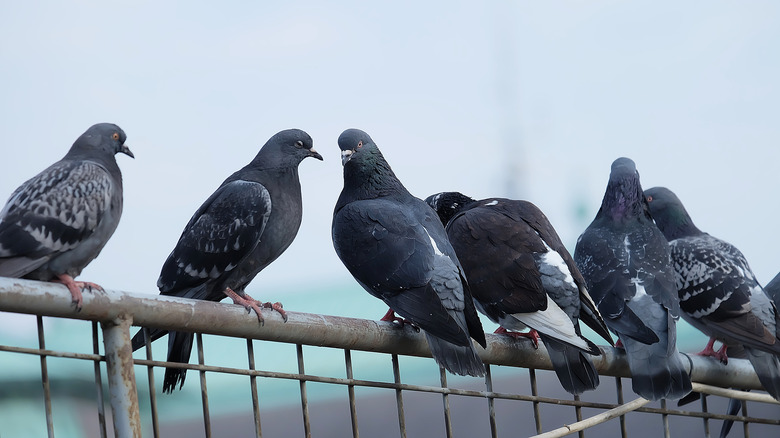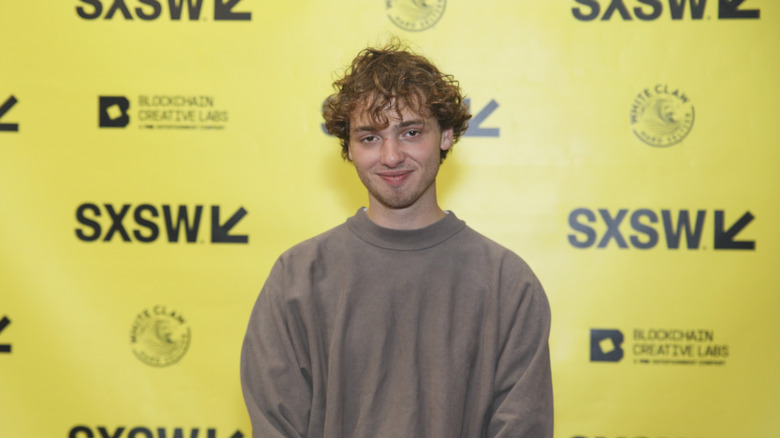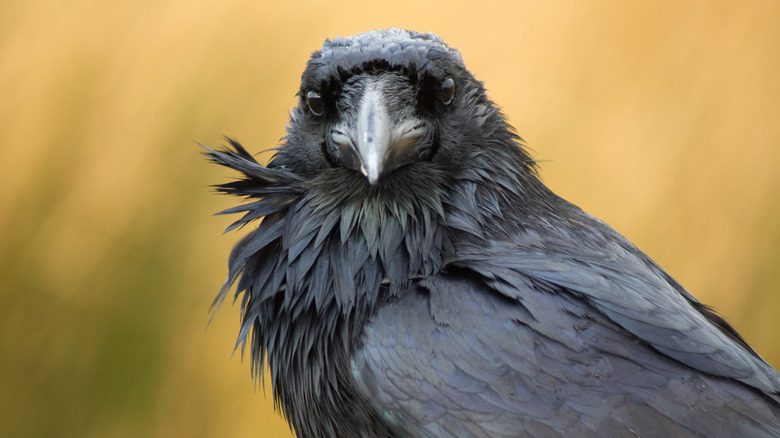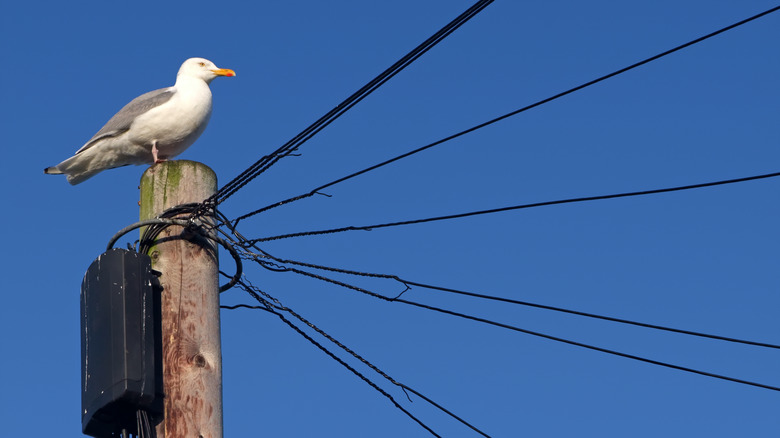The Origin Of The Birds Aren't Real Conspiracy Theory
Birds have been flying through the skies for millions of years and continue to do so. At least, that's what the government wants you to think. Conspiracy theories have been around since people had reason to conspire about things or accuse them of conspiring about things. In the 21st century, that has no sign of slowing down, though it would seem that the conspiracy theories are getting wilder and wilder. Case in point: the conspiracy theory that birds aren't actually real. At least, they're not anymore, having been replaced by the CIA in exchange for surveillance technology.
It sounds ridiculous to most people, but that's the point. "So it's taking this concept of misinformation and almost building a little safe space to come together within it and laugh at it, rather than be scared by it," Peter McIndoe, the originator of the satirical internet conspiracy, told "60 Minutes." "And accept the lunacy of it all and be a bird truther for a moment in time when everything's so crazy."
What McIndoe couldn't have anticipated was that his attempt at satire would be so successful that it would take the internet by storm and even lead some people to believe that birds aren't real.
Conspiracy theories through history
While the "Birds Aren't Real" movement is itself a satire of the modern prevalence of conspiracy theories, conspiracy theories themselves are nothing new and have been around for many years. According to Memory Studies, there were conspiracy theories as far back as the Roman Empire, specifically surrounding the great fire of Rome. Studies have shown that conspiracy theories tend to crop up during moments of crisis.
A study by political scientists Joseph E. Uscinski and Joseph M. Parent looked at over 100,00 letters that have been sent to The New York Times and indexed the ones with conspiratorial content. They found spikes at certain points in history. One spike appeared just before 1900 and was attributed to the Second Industrial Revolution, a time of rapid and immense economic change. Another spike was noticed in the late 1940s and early 1950s, just as the Cold War between the United States and the Soviet Union was beginning.
Conspiracy theories are not limited to Western cultures and have been observed around the world. Some point to this as evidence that believing conspiracy theories is an aspect of human nature — rather than something cultural — and is a method for navigating crises.
The start of Birds Aren't Real
According to its website, the Bird's Aren't Real "movement" started decades ago in an effort to reveal the truth behind the United States government's covert program to remove birds. That program was the brainchild of Allen Dulles, the first civilian director of the CIA, because the avian creatures would "often poop on their cars in the parking lot of the CIA headquarters, and quite frankly — all over the D.C. Metro area." The CIA then replaced the real birds with robotic versions that doubled as surveillance equipment.
Of course, that's not the real story. The real story is that Birds Aren't Real was started in 2017 when Peter McIndoe and some friends saw demonstrators on the streets of Memphis, Tennessee, the day after former President Donald Trump's inauguration. "I remember thinking it would be very interesting if someone was in this situation with a sign that had nothing to do with anything that's going on here," McIndoe said. He got to work crafting a sign and settled on "Birds Aren't Real" because it was the most preposterous thing he could come up with at the moment.
Birds Aren't Real became very popular very fast
It would've been a funny story to tell friends if that was the end of the whole Birds Aren't Real spectacle, but Peter McIndoe realized that there were ways to take it further. According to The New York Times, the Birds Aren't Real movement harnessed the internet and members of Generation Z — who themselves grew up using the internet at a moment in time when there was another spike in conspiracy theories — to spread the tongue-in-cheek conspiracy theory.
The Birds Aren't Real movement spread rapidly. "So I'm getting pictures sent to me of Birds Aren't Real graffiti and Birds Aren't Real chalkboards and seeing you know chants in cafeterias and, you know, stadiums like 'Birds Aren't Real' at high schools," McIndoe told "60 Minutes." Pouncing on their spur-of-the-moment goof's newfound internet fame, McIndoe enlisted a friend to help him craft a backstory explaining the faux-history of Birds Aren't Real.
Birds Aren't Real became so popular that McIndoe decided to drop out of school to pursue his new internet enterprise, though explaining the choice to his parents was a little difficult. "I was trying to describe to them it could be a very interesting art project, sort of like a mirror to, you know, just the seemingly exponentially growing absurdity of the world and America," McIndoe said in his "60 Minutes" interview. "And, like, if we can match that with a character in a living world, blah, blah, blah. And they're just lookin' at me, like, 'Please stick with the psychology degree,' you know."
Some people still believe that birds aren't real
While to most people, the satirical nature of Birds Aren't Real is readily apparent, for some, the line between satire and reality has become increasingly blurred. According to The New York Times, Peter McIndoe spent the first few years in character, masquerading as the movement's figurehead whistleblower. However, he decided to reveal himself after people really believed that the birds we see today are nothing but government drones. "Everything we've done with Birds Aren't Real is made to make sure it doesn't tip into where it could have a negative end result on the world," he said.
Nonetheless, there are still those who have bought into it hook, line, and sinker. Connor Gaydos, who helped write the Birds Aren't Real backstory, told "60 Minutes" that he has had encounters with people in which Birds Aren't Real comes up, and they indicate that they're aware of the entire conspiracy — just not necessarily in the way it was intended.
Could Birds Aren't Real accidentally exacerbate the problems it pokes fun at?
One criticism levied at the Birds Aren't Real movement is the possibility of it backfiring, and instead of poking fun at the idea of conspiracy theories and misinformation, it inadvertently makes things worse. Shades of that are noticeable with the satirical movement's founders meeting people who truly believe that birds are now nothing more than robotic surveillance devices. During an interview with The Guardian, Peter McIndoe admitted that sometimes the faux-conspiracy theory is embraced by the wrong people — or perhaps the right people, albeit in the wrong way. "Real conspiracy theorists will approach me like I'm their brother, like I'm part of their team. They will start spouting hateful rhetoric and racist ideas, because they feel as if I'm safe."
However, McIndoe also noted that other real-life conspiracy theories have gone one level deeper by choosing to believe that Birds Aren't Real is a conspiracy theory set up by the CIA to try to discredit conspiracy theorists. "They think Birds Aren't Real is a CIA psy-op. They think that we are the CIA, we're put out there as a weapon against conspiracy theorists," McIndoe said.





